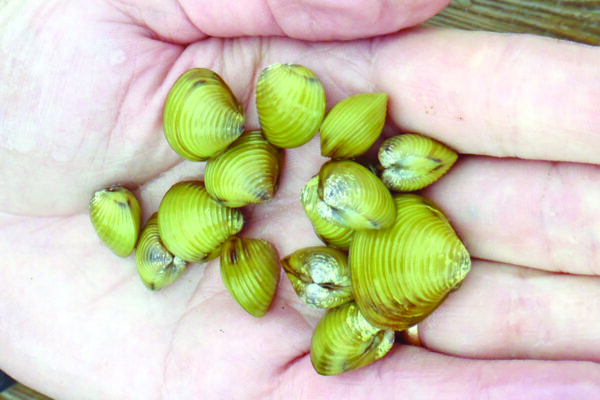Asian Clam

Species at a Glance
The Asian clam (Corbicula fluminea), also called the Asiatic clam, pygmy clam, or gold clam, is a small, freshwater bivalve that rarely exceeds the size of a nickel. This biofouler has spread rapidly in lakes, canals, streams, rivers, and reservoirs, threatening ecosystems and lakeside communities all throughout North America.
Species Description
The shell of the Asian clam is thick, triangular in shape, and has deep distinctive growth rings. They are typically small, averaging less than 2.5cm (1 in) and rarely exceeding 6.5 cm (2.5 in). There are two morphs of Asian clam in the United States. A lighter morph, with an outside shell typically yellow-green to brown in color is found in the northeast; and a darker morph exists in the southwestern United States. The inside of the shell is layered with polished, light purple nacre, and finely serrated teeth. Juveniles are free-floating and microscopic, called veligers, and appear under a microscope in a “D” shape less than 1 mm in length.
Native & Introduced Ranges
Native to the temperate and tropical regions of Southeast Asia and Africa, it is believed that the Asian clam was first introduced to the west coast of the United States in 1924 to be harvested as a food source. By the 1970s, it occupied most of the Mississippi River Basin, the Gulf Coast, and the eastern United States. In Pennsylvania, the Asian clam is widespread and can be found in the Allegheny, Monongahela, Ohio, Susquehanna, Delaware, and Schuylkill rivers and their tributaries as well as many other lakes and streams in Pennsylvania.
Biology & Spread
The Asian clam is a prolific and highly competitive species that is capable of rapid growth and spread. Because it is hermaphroditic, the Asian clam is capable of self-fertilization, and a single clam can release hundreds to thousands of free-floating, microscopic larva per day. In warmer waters this spawning activity can take place year round, creating ample opportunities for juveniles to be spread by water currents and human activity as they go unseen in bait buckets and livewells.
Asian clams can be spread as they attach to boating, fishing, and scuba diving equipment and be transported to new waterways. They are also still sold commercially as bait throughout the United States, and in the aquarium trade as pygmy or golden clams.
Habitat
While Asian clams are a hardy and persistent species, they prefer running water with a sandy or gravel substrate bottom. Therefore, they are often found in streams, rivers, ponds, lakes, and constructed canals. They are considered a freshwater species, but can withstand slightly brackish waters and estuarine populations have been reported on both the east and west coasts. They also prefer to colonize in warmer areas near the shore with plenty of sunlight, and although they are able to withstand freezing conditions, their ability to reproduce decreases with exposure to lower temperatures.
Impacts
Threat to Biodiversity
Dense clusters of Asian clams, often reaching over 6,000 individuals/m2, can alter the natural benthic community of an ecosystem. They are efficient filter feeders, consuming microscopic plants and animals from the base of the food chain and competing with native mussels, juvenile fish, and other native aquatic organisms for food. Since they are capable of tolerating polluted environments better than many native bivalves, Asian clams are displacing native species. In many areas, native mussels are in danger of becoming extinct due to the infestations of Asian clams.
Economic Costs
The Asian clam is a known biofouler, causing millions of dollars in damage each year for power plants and industrial water systems. Asian clams clog pipes, irrigation canals, and intake systems, and damage equipment like boat motors, diving gear, and commercial water systems. In addition, they impair the aesthetic and recreational values of public beaches, lake front properties, and swimming areas.
Prevention & Control
Early detection is the first line of defense in preventing the spread of this species to new areas. Know how to identify the Asian clam and distinguish it from native mussels.
- Always check for and remove plants, mud, and debris from boats, trailers, clothing, and equipment before entering a new water body and when leaving a water body.
- Drain all water from bait buckets, bilges, and live wells before transporting to new areas. Clean all gear and equipment with hot water or salt water, OR let boats and equipment dry thoroughly for at least five days before entering a new water body.
References:
- Hunter, B. Asian Clam (Corbicula fluminea). Illinois-Indiana Sea Grant.
- Massachusetts Department of Conservation and Recreation. Established, Asian clam: An exotic aquatic species.



